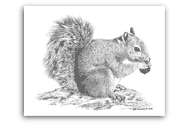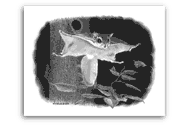 |
 |
 |
BEARS BEAVERS
BOBCATS CAMELS CHEETAHS
CHINCOTEAGUE PONIES
CHIPMUNKS DEER
ELEPHANTS FOXES
GAZELLES GIRAFFES
GOATS GORILLAS
HIPPOPOTAMUS JAGUARS LEOPARDS
LIONS MOOSE OTTER
RABBITS RACCOONS
RHINOCEROS SQUIRRELS
TIGERS WOLVES
WOODCHUCKS ZEBRAS
|
 |
 SQUIRRELS
(Click on an image to see the actual notecard
size) SQUIRRELS
(Click on an image to see the actual notecard
size) |
|
|
GRAY
SQUIRREL
#SQL-500
Notecards Only
Also available in Notecard Assortment Packs #AST-501
& #AST-502
Gray
squirrels are found throughout the eastern half of the United States
and in southern Canada. Habitats include broad-leafed forests, city
parks and suburban areas.
Their
basic diet consists of acorns and hickory nuts. In addition, they
feed on a great variety of succulent buds, various fruits and berries,
seeds and even insects. In the fall, gray squirrels spend a lot
of time gathering nuts. Some are eaten and some are buried. In winter
they rely on their buried food for sustenance, as well as birdseed
stolen from backyard feeders. Many buried nuts are forgotten and
may eventually sprout and become trees.
Nesting
is normally in high, old tree cavities cushioned with leaves and
moss, but gray squirrels also construct leafy nests in tree branches
to use mainly as feeding shelters and for sunning.
Gray
squirrels may breed in midwinter and again in late spring. Late
winter or spring litters are usually born in tree hollows, summer
litters in leafy nests. Males play no part in raising the young,
which average two to four per litter and nurse for about nine weeks.
When the young are about forty days old, they can eat solid food
and will even venture out from their nest.
Text
© 1995 Dianne Harrah, Drawing © 1995 Bill Harrah.
|
Back to Top |
|
 |
 |
|
SOUTHERN
FLYING SQUIRREL
#SQL-501
Notecard
Also available in Notecard Assortment Pack #AST-506
#LE-SQL-501 Limited Edition Print
Having
scrutinized its landing site before springing from its den high
in the forest, this airborne southern flying squirrel extends all
four legs at right angles from the body to stretch its gliding membrane,
or patagium. Using its broad, flat tail as a rudder, it can steer
agilely around branches or other obstacles. It also manipulates
its tail and patagium to control speed, enabling it to land upright
with the hind feet touching first, usually on the vertical trunk
of another tree.
The
spectacular glide of southern flying squirrels most often occurs
at night, perhaps so they can avoid detection by hawks and other
daytime predators. Although they typically land 20 to 30 feet from
their starting point, glides up to 240 feet have been recorded.
These squirrels are less than a foot long, including tail, and weigh
a mere two to four ounces.
Text
© 2001 Terry White, Drawing © 2001 Bill Harrah.
|

Flying
Squirrel
#LE-SQL-501
Limited Edition Print
Issue Date: 03/2002
Edition Size: 500
Image: 6.5” x 8.25”
Paper: 8.5” x 11”
Mat: 11” x 14”
$35.
View
matted print
|
 |
|
 |
|
|
 |
|
Copyright
Notice
Drawings Copyright © 1992-2013 Bill Harrah, Wolf Run Studio (SM), All Rights
Reserved. Wolf Run Studio is a service mark of Bill Harrah and has been in continuous
use since 1992. All of the images on this website are in tangible form and are
fully copyrighted. Each has an invisible digital identification which is traceable
through the Digimarc Corporation. Viewers of the Wolf Run Studio website are
allowed to browse and print out images for personal, non-commercial use only.
You may not distribute copies of images or image files to anyone else for any
reason. Images may not be reproduced or used in any form or any manner, or displayed
on any website without the express written consent of Bill
Harrah.
Text Copyright
© 1992-2013
Terry White or
Dianne Harrah. Text on this website is used with permission from the authors.
Viewers of the Wolf Run Studio website are allowed to browse and print out text
for personal, non-commercial use only. Text may not be reproduced or used in any
form or any manner without the express written consent of the authors.
Information
Accuracy
The information for the written description of each animal has been carefully
researched by the authors and is believed to be accurate. New scientific observations,
however, could make some information out-of-date. If you are a professional
zoologist, and have new information that you are willing to share, please contact
Dianne Harrah .
|
|
|
|
|
|
|



